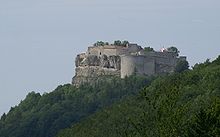Hohenneuffen Castle

Hohenneuffen Castle is a large ruined castle in the northern foothills of the
.Location
The medieval castle is situated on a large late Jurassic rock on the edge of the Swabian Alb at an elevation of 743 m (2437 ft) in a strategically advantageous location on the slopes of the mountain range.


History
There is evidence for a pre-historic, Iron Age settlement on Hohenneuffen. It functioned as an outpost for the oppidum at Heidengraben during the late La Tène period in the first century BCE.
The pre-Germanic name Neuffen is derived from the proto-Celtic adjective nobos, meaning holy or sacred, implying that the mountain had a religious rather than a military function 2000 years ago.
The castle was built between 1100 and 1120 by
The expansion of Hohenneuffen Castle into a fortress began in the 14th century. However, the most important alterations to the castle structure were conducted by
The castle was besieged by Imperial forces for more than a year during the Thirty Years' War. In November 1635 the commanding officer Johann Philipp Schnurm and his dispirited troops managed to negotiate a surrender, allowing Schnurm and his men to depart with their weapons and possessions. Yet, in violation of the agreed terms the troops were forced to serve in the Imperial army and Schnurm lost all his possessions.[5]
Duke
Similar to other fortresses Hohenneuffen was used as a holding place for prisoners of the state, where important prisoners were held and, if deemed necessary, tortured. Amongst those were a young

The Three-States-Conference
During the Allied occupation of Germany following the end of World War II, the military governments of the American and French occupation zones founded three states in their zones in 1946 and 1947: Württemberg-Baden in the American zone, Württemberg-Hohenzollern and Baden in the French occupation zone. When it became known that a constitution was being worked out for West Germany, a number of politician took the initiative to merge the three south-western states. The prime minister of Württemberg-Baden, Reinhold Maier, invited the governments of the three states to a conference which took place on 2 August 1948 at Hohenneuffen Castle. His idea was to bring the governments closer together in order to prepare for the formation of a new state in the southwest of Germany. The delegation from Baden was headed by Leo Wohleb, an uncompromising advocate of the restoration of the former Baden. Württemberg-Hohenzollern was represented by its home secretary, Viktor Renner.[8] Maier had chosen the place for the conference with care. The wide view from the top of the mountain, particularly onto the border of the occupation zones which ran between the district of Reutlingen and the then district of Nürtingen, was meant to impress the delegates. Secluded from their respective governmental apparatus and the public, the participants were supposed to be able to engage in discussions without any disturbances. However, no agreement was reached at the end of the conference. Nevertheless, it marked the beginning of the process which led to the formation of the so-called Southwest State in 1952: Baden-Württemberg.[9]
Current use
Today, access to Hohenneuffen Castle is free for the public and some of the casemates are accessible. There is also a restaurant, beer garden and a kiosk.
A fell running event (Hohenneuffen-Berglauf) takes place every June. Participants have to cover a distance of 9.3 km and a difference in altitude of 483 metres.[10]
Furthermore, the castle is also used for concerts and a medieval-style market.
See also
References
- ^ H. Ossenberg: Was bleibt, das schaffen die Baumeister, p. 309
- ^ G. Schweikle, Dichter über Dichter in mittelhochdeutscher Literatur, p. 136
- ^ "Burg Hohen Neuffen - Geschichte" (in German). Archived from the original on 28 July 2007. Retrieved 25 January 2010.
- ^ Baedecker Allianz Reiseführer Schwäbische Alb, 2007, p. 274
- ^ F. Fischer, Der Heidengraben bei Grabenstetten, p. 143ff.
- ^ "Hohenneuffen - Geschichte". Stadt Neuffen. Archived from the original on 10 February 2010. Retrieved 25 January 2010.
- ^ S. Stern, The Court Jew, p. 257
- ^ E. Kuhn, Das grosse weite Tal der Möglichkeiten, p. 161f.
- ^ F. Crivellari: Baden am Scheideweg, p. 50
- ^ "Hohenneuffen - Berglauf" (in German). Retrieved 25 January 2010.
Further reading
- Bär, Walter (2004). Der Neuffen. Geschichte und Geschichten um den Hohenneuffen (in German). Neuffen: Stadt Neuffen.
- Crivellari, Fabio (2002). "Baden am Scheideweg": Konstanz und die Gründung des Südweststaats (in German). Konstanz: ISBN 3-89669-778-1.
- Fischer, Franz (2002). Der Heidengraben bei Grabenstetten, ein keltisches Oppidum auf der Schwäbischen Alb bei Urach (in German) (3rd ed.). Stuttgart: Theiss. ISBN 3-8062-0317-2.
- Kuhn, Elmar L. (2002). Das große weite Tal der Möglichkeiten. Geist, Politik, Kultur 1945 - 1949; das Projekt Gesellschaft Oberschwaben (in German). Nürtingen: Kunstverlag Fink.
- Maurer, Hans-Martin (1967). Burgruinen im Landkreis Nürtingen (in German). Nürtingen: Landkreis Nürtingen. ISBN 3-89870-051-8.
- Ossenburg, Horst (2004). Was bleibt, das schaffen die Baumeister. Das Württembergische Hof- und Staats-Bauwesen vom 15. bis 20. Jahrhundert (in German). Norderstedt: Books on Demand. ISBN 3-8334-0633-X.
- Schweikle, Günther, ed. (1970). Dichter über Dichter in mittelhochdeutscher Literatur (in German). Tübingen: Niemeyer.
- Stern, Selma (1950). The Court Jew. A contribution to the history of the period of absolutism in central Europe. Philadelphia: Jewish Publication Society of America.

